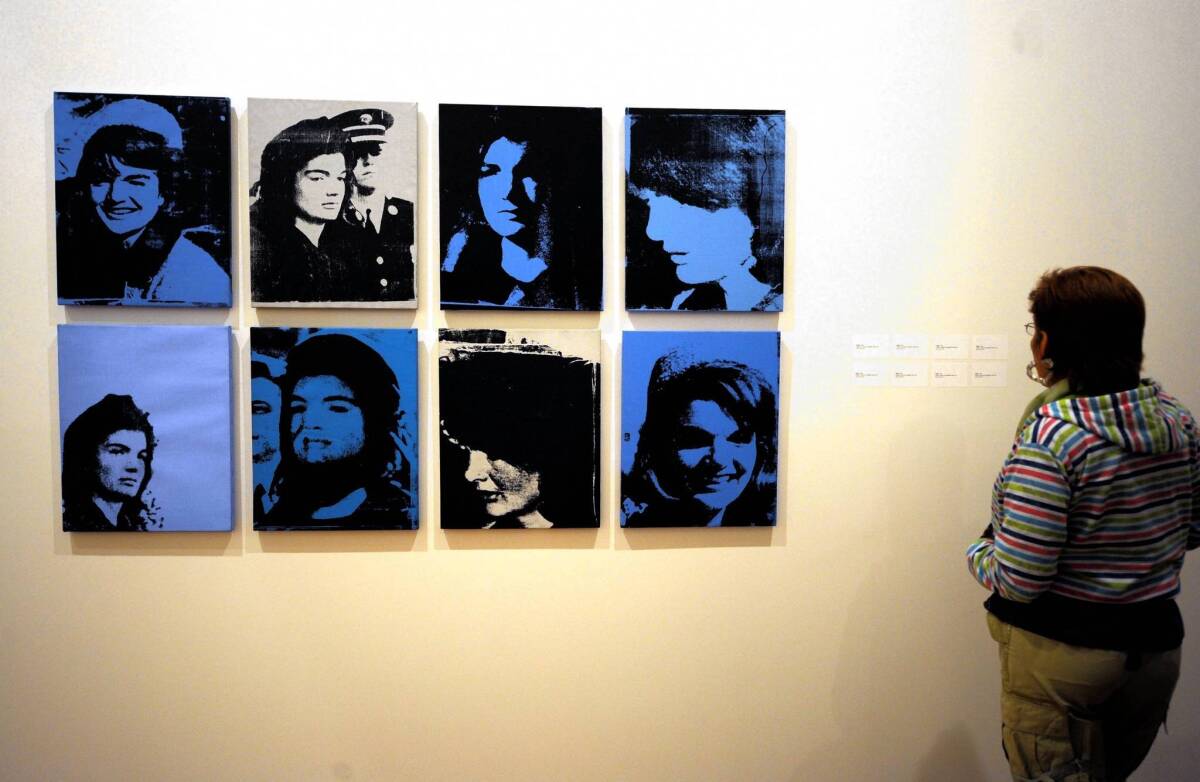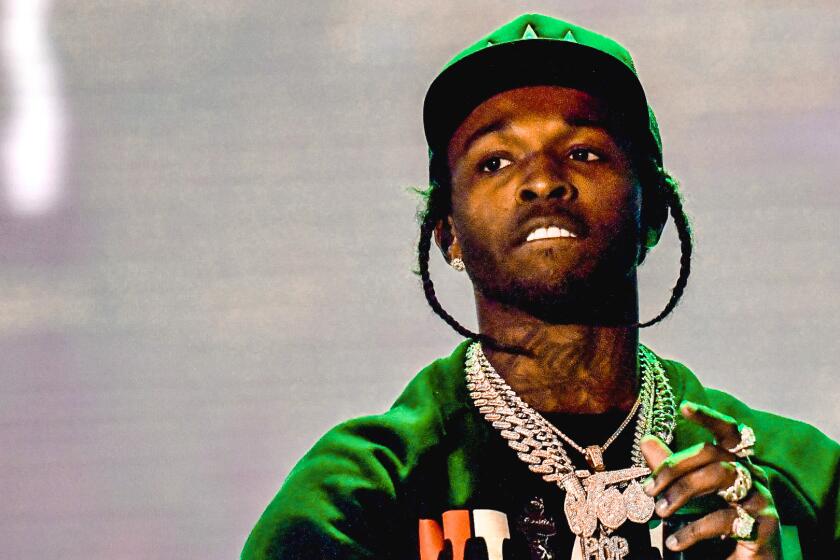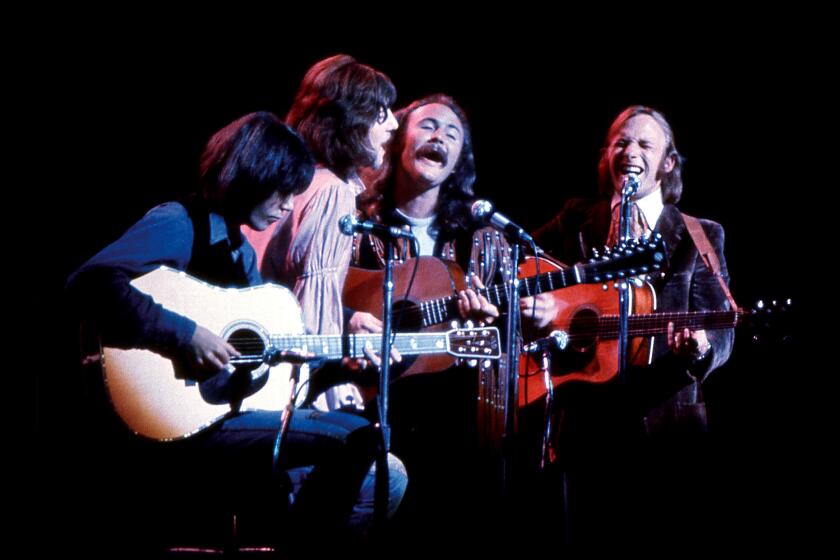Andy Warhol’s ‘Jackie’ works were his ‘Guernica’

- Share via
For art, the 1963 murder of a president became America’s Guernica.
In style, emotional tenor and generation, Pablo Picasso and Andy Warhol were very different artists. But both made paintings that spoke to an epic social trauma of their day. And both used the same motif — a weeping woman — to focus the unfathomable event.
Over three hours in the afternoon of April 26, 1937, German bombers pummeled an ancient Basque village in Northern Spain with a hundred thousand pounds of high-explosive and incendiary bombs, reducing the town of Guernica to smoking rubble. Shock waves spread across Europe.
Picasso, then 55 and a mature artist, went to work. In a few weeks’ time he completed a big painting that would become an anguished modern icon of anti-war protest.
The brutal event in Spain’s bloody civil war was different in scale from the Dallas assassination of John Fitzgerald Kennedy, the charismatic young president of the United States, 26 years later. But for both, the shock to the public psyche was huge.
Warhol, just 35 and still finding his artistic footing, took time to figure out how to respond, but when he did, Picasso was his backup. In dozens of paintings of Jackie Kennedy, Warhol transformed Picasso’s “weeping women,” a celebrated series of paintings, drawings and prints born out of a prominent motif in “Guernica” showing unspeakable grief.
Picasso made nearly 60 of them — wrenching pictures of women’s faces, all sharp angles, bleary forms, clashing colors and scarified marks. A cataclysmic public tragedy fused with his contorted relationship with three important women — his estranged first wife, Olga Koklova; his long-suffering mistress, Marie-Thérèse Walter; and his new lover Dora Maar, the emotionally fierce Surrealist photographer.
Warhol looked to a single weeping woman. In the first weeks of 1964 he turned to the picture press, especially Life magazine. He chose eight photographs of Kennedy’s widow from the mass media’s avalanche of assassination coverage, including the run-up and the aftermath.
PHOTOS: How TV reacted to JFK’s assassination
Jackie attired in a pillbox hat and happily arriving at Love Field in Dallas. Jackie, stunned, aboard Air Force One at Lyndon B. Johnson’s swearing-in as the new president. Jackie shrouded in a black veil and leaving the White House for the Capitol rotunda or grieving at Arlington. The artist sent these and other found-photographs to his silk-screen technician, instructing him to dramatically heighten the originals’ contrast between dark and light.
Black acrylic was used to silk-screen them, sometimes flopped, onto blue or silver canvas panels or sheets of paper. (A few are gold, as if for a Byzantine icon depicting a saint, while other colors turned up in later versions.) The blue and silver palette recalls black-and-white TV; that’s how most people experienced the traumatic events of the previous autumn, now being represented at another remove.
We never see tears streaming from her profoundly sad eyes. Still, I believe Picasso was essential to Warhol’s choice of Jackie, not Jack, for the assassination series. Barely 18 months before Kennedy’s murder, New York was awash in a celebration of the great Spaniard’s art.
“Picasso: An American Tribute” was a sprawling, late-April retrospective that filled nine of the city’s most prominent galleries, including Staempfli, Perls and Knoedler. The lavish tribute was organized by John Richardson, an art historian and the painter’s neighbor in the south of France. An hour-long NBC television special on Easter Monday even catapulted the local extravaganza nationwide.
In a final triumph, the gallery and TV shows were followed by a summer-long Museum of Modern Art exhibition, organized in belated celebration of Picasso’s 80th birthday. In all, the civic extravaganza lasted nearly six months. “Guernica” was a centerpiece.
Warhol was obsessed with Picasso — more specifically, obsessed with his standing as the greatest living Modern artist. Since arriving in New York from Pittsburgh a dozen years earlier, the ambitious younger painter had gotten nowhere. But just as the Picasso bandwagon rolled into town, he was finally getting traction: His Pop solo gallery debut — Campbell’s soup can paintings at Los Angeles’ Ferus Gallery — even coincided with MOMA’s Picasso birthday salute.
Once his own star rose, Warhol declared his Picasso affinity. In 1966 he covered a room at New York’s Leo Castelli Gallery with a surrogate self-portrait — bright yellow wallpaper sporting the hot-pink head of a cow. For the effeminate gay artist, the coy pink cow was equivalent to Picasso’s famous self-identification with a robust bull or mythic Minotaur. Warhol repeated the coquettish gesture in his first big international museum solo shows — in Stockholm in 1968 and then in 1970 at the Pasadena (now Norton Simon) Art Museum.
Just below the bull’s head in “Guernica,” Picasso painted his first weeping woman. Her splayed hands clutch the limp body of a dead child, her head with teardrop eyes tossed back in a piercing shriek.
In this secular pietà, she’s a descendant of Our Lady of the Sorrows, an old religious convention in European painting. The Mater Dolorosa portrays the Virgin Mary shedding tears for the plight of humanity, embodied in the trials of her martyred son.
A marvelous 1994 exhibition at the Los Angeles County Museum of Art showed how Picasso’s post-”Guernica” works took a deeply personal turn. The show, inspired by his great “Weeping Woman With Handkerchief” in LACMA’s collection, demonstrated the way his fury with the civic slaughter was layered with his tumultuous private life.
“Guernica” was powerful public agit-prop. Picasso marshaled grand scale, figurative distortion, mythic narrative and a stark palette of black and white that derived from newspaper accounts of the awful event. At the 1937 Paris International Exposition, where the mural-size canvas had its public debut before an international tour, its prominence in the Spanish Pavilion meant to grab viewers by the lapels. A distracted world was shaken into awareness.
Warhol obviously didn’t need to do that for the Kennedy assassination. By the ‘60s, television’s instant communication took care of galvanizing the public.
In fact, his paintings worked against the media manipulation that Picasso deftly exploited. Warhol’s weeping woman was smudged, repetitive and unemotional. Jackie presents high contrast and low information, all available in mute mathematical permutations — four panels, eight, 16 or even an entire roomful, as Castelli soon showed them.
Warhol was happy having JFK as president, but he was largely unmoved by the assassination. “[It] didn’t bother me that much that he was dead,” the artist later said, comparing the public pageant of mourning for Kennedy to a moving funeral for an anonymous peasant that he once stumbled on in India.
“What bothered me was the way the television and radio were programming everybody to feel so sad,” he said. “It seemed like no matter how hard you tried, you couldn’t get away from the thing.” Media manipulation was a new way of life in postwar America.
Warhol’s weeping women are cold, Picasso’s are hot. Picasso’s boil over, Warhol’s remain numb. Picasso’s are violently intimate, Warhol’s passively remote. Picasso prized individual heroics, Warhol disappeared into the crowd.
But like Picasso, Warhol understood that art can function as a powerful social lever. His emotionally neutered Jackie portraits used American popular culture as a weapon, not a target. Warhol’s icy weeping woman put Picasso squarely in the cross hairs — Picasso and all the accumulated mythologies and pretensions of established Modern art.
The younger artist had no choice. For as long as art’s old aesthetic machismo held sway, there simply was no room for the likes of him. So, with the deliberateness of an assassin, Warhol coolly killed it off.
More to Read
The biggest entertainment stories
Get our big stories about Hollywood, film, television, music, arts, culture and more right in your inbox as soon as they publish.
You may occasionally receive promotional content from the Los Angeles Times.











